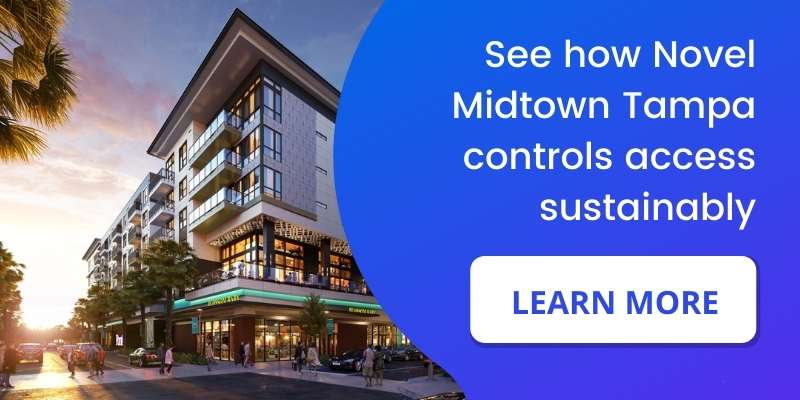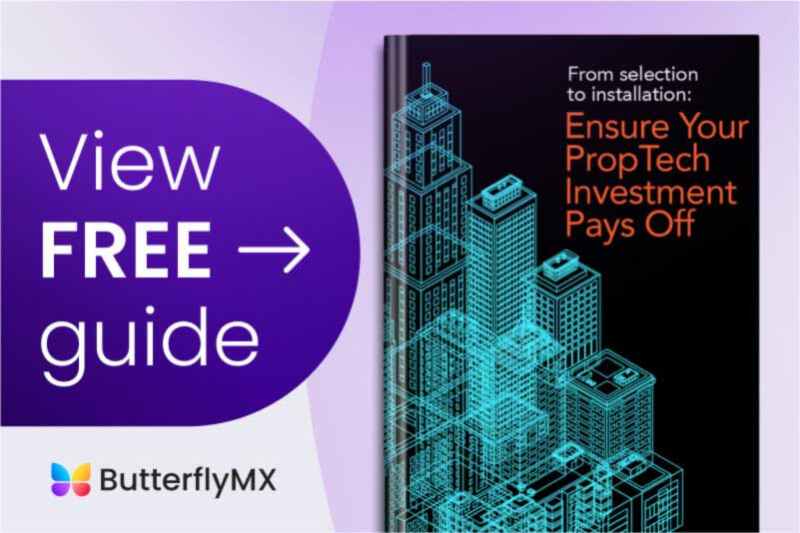Key takeaways
- Creating a more sustainable building can be as simple as making a few small changes like installing solar panels or offering a bike share program.
- As a real estate professional, one of the most impactful ways for you to prioritize sustainability is to develop mixed-use properties.
- There are plenty of resources from expert sources like the EPA and National Renewable Energy Laboratory that cater to real estate specifically.
- While there is no one right way to run a sustainable building, many certifications do exist to help you evaluate if your property is on the right track.
- Smart technology investments, like a wireless intercom, are the quickest and easiest way to make your existing building more efficient.
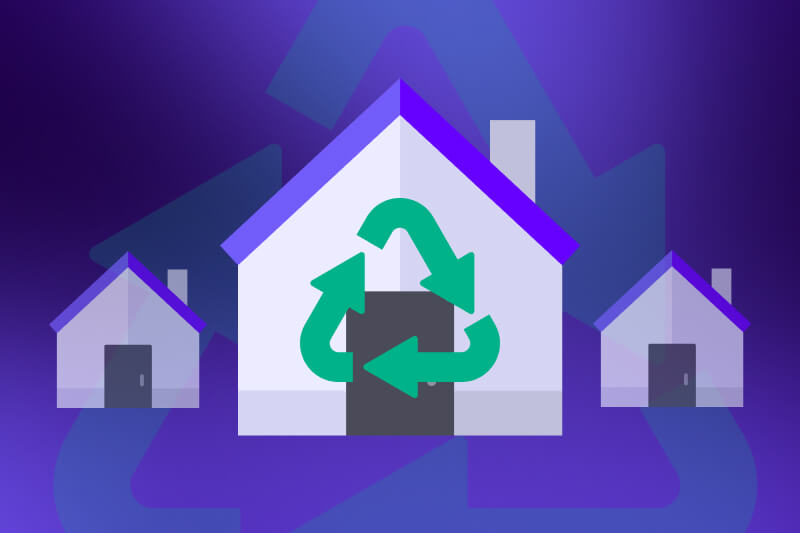
Climate change is a hot topic in all industries and real estate is no exception. So how will you factor sustainable building into your business model? This guide will help you incorporate sustainability into your existing properties as well as your plans to design, construct, and manage new ones.
Navigate this sustainable building guide:
- What is meant by a sustainable building?
- What are the 7 components of green building?
- What’s an example of a sustainable building?
- How can buildings be sustainable?
What is meant by a sustainable building?
Sustainable building is a strategy for constructing, designing, and managing properties so there is as little environmental impact as possible. A sustainable building is also sometimes called a green building or eco-friendly building.
The definition of sustainability differs for everyone. There isn’t just one way to be eco-friendly. Follow the latest sustainability news through EPA publications to get the best information. You can even narrow your search by location to get the most relevant details for your area.
So, what is sustainable building? It’s all about doing your best to reduce your property’s environmental impact. However, no one is perfect. What is considered sustainable now will change over time as cities become more walkable, new energy sources emerge, and technology introduces ways to further reduce our carbon footprint.
Watch to learn about how to implement sustainable building:
What are the 7 components of green building?
It’s up to you how you’d like to incorporate sustainability into your property. However, green building certifications are all based on a similar set of sustainable building practices. Even if you aren’t aiming for certification, the criteria can give you ideas for how to improve your own property.
The seven components of sustainable building are:
- Energy: Is your building using energy efficiently? Do you use any renewable power sources? How can you reduce energy consumption overall?
- Building materials: Are you using the most sustainable building materials available to you? Have you followed the EPA and DOE recommendations?
- Waste: How much waste does your building produce? What are you doing to reduce the amount of waste? Are you disposing of waste in the most environmentally friendly way available?
- Toxicity: Are you replacing toxic products with alternative building materials? Have you used chemical assessment tools to choose the safest products possible? Do you have a risk management plan for keeping your building safe?
- Water: Does your building have water-efficient products installed? Are you reducing the use of water overall? Do you have any water recycling programs at your building?
- Air quality: Have you followed construction specifications to reduce indoor air quality problems? Does your building have air quality monitoring installed? How are you improving or maintaining your indoor air quality?
- Scalability: As your business grows, how are you planning for sustainability? Are you redeveloping old properties to be more sustainable? How are you keeping up with changing environmental standards? Are you using low-impact development techniques?
What is an example of a sustainable building?
There are many examples of sustainable building design out there where you can get inspiration. Novel Midtown in Tampa, Florida is one such example.
The Novel Midtown apartment complex is not only designed with resident health and wellness in mind but it is also Fitwel certified. This certification verifies that the property values sustainability issues like indoor air quality and non-toxic building materials.
Additionally, the mixed-use design of Novel Midtown means that residents can enjoy a gym, coworking space, dry cleaning, and more, all without getting in the car. This style of sustainable building not only improves the property but also makes eco-friendly living easier for tenants.
How can buildings be sustainable?
So now that you know what sustainability means for the real estate industry, what should you do next? Whether you’re looking to construct a sustainable office building or improve an existing residential building, there are several tips you should consider.
Six quick tips to make your building more sustainable:
- Incorporate biomimetic architecture and biophilic design
- Use sustainable energy sources
- Encourage sustainable practices for tenants
- Prioritize transit-oriented development
- Invest in smart technology
- Adopt adaptive reuse architecture principles
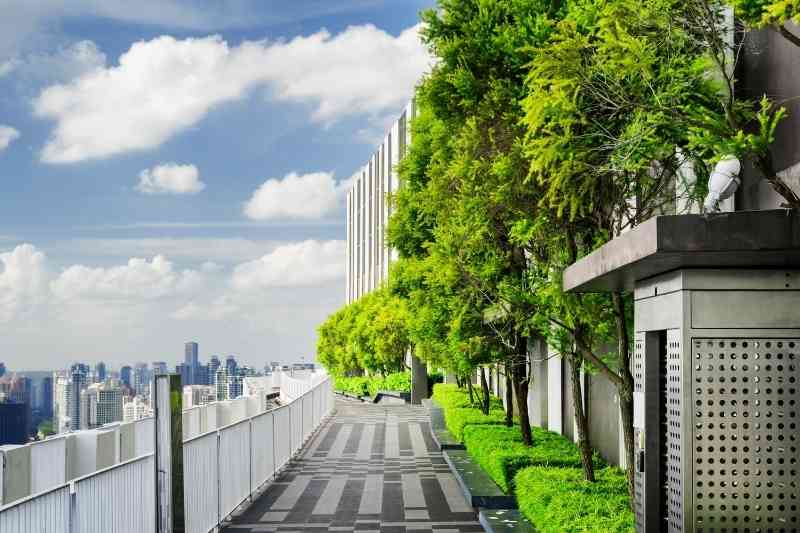
1. Incorporate biomimetic architecture & biophilic design
Biomimetic architecture is a movement that incorporates inspiration from plants, animals, and other things found in nature into building designs. Meanwhile, biophilic design is a real estate movement that brings nature into a building’s architecture and design. Incorporating nature into your building is not only more aesthetically pleasing but can also improve sustainability.
Try the following biophilic design ideas at your property:
- Build community gardens so tenants grow their own produce
- Add plants and trees that can improve indoor air quality
- Plant trees outside to naturally cool your property in the summertime
2. Use sustainable energy sources
As the world shifts to prioritize renewable energy, buildings will have easier access to sustainable solutions. Bringing sustainable energy sources to your building may be cheaper and easier than you think.
For example, solar panels are more efficient and affordable than ever before. You can use solar panels to offset or even replace coal, gas, and electricity usage while enjoying a variety of other benefits. Solar panels are not only better for the environment but also appeal to a wider range of tenants. Overall, solar panels can lower energy bills at your property so you’ll see a great ROI.
And there’s more:
The National Renewable Energy Laboratory even published a guide to adding renewable energy sources to your existing building. So, even older properties can be greener.
Other sustainable energy sources include:
- Wind farms or micro-wind turbines
- Hydropower
- Geothermal
- Tidal energy from the ocean
What’s more, you can retrofit or develop your building using Passive House standards. Those are guidelines for ensuring the indoor temperature is always comfortable for tenants while keeping energy usage to a minimum.
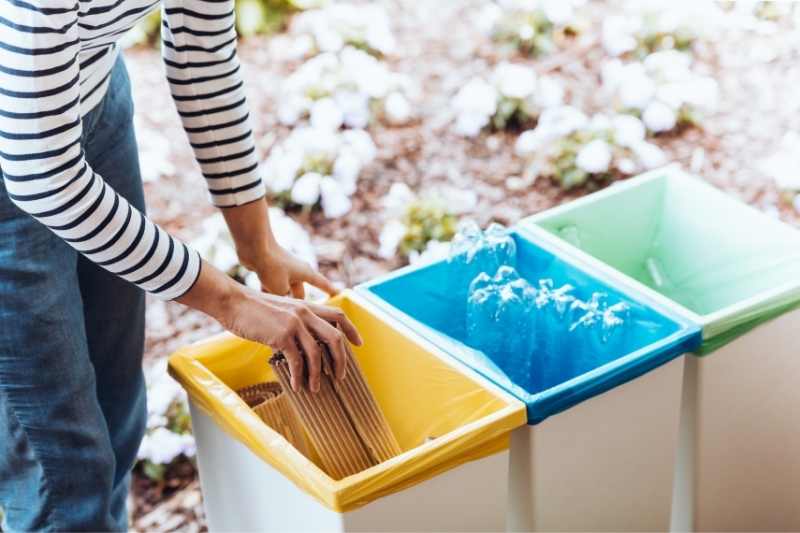
3. Encourage sustainable practices for tenants
When it comes to building sustainable communities, your tenants want to get involved. Don’t just install new technologies behind the scenes. Share the news with your community. Not only will all your hard work in sustainability attract prospective tenants, but it will also improve your relationship with existing tenants.
More people than ever are prioritizing sustainability issues. So, as you improve your sustainable building, let your tenants know how they can help. Hanging signs and sharing newsletters are great ways to get the word out.
While most of the steps for a sustainable building are on you, let residents know that they can help in the following ways:
- Taking advantage of recycling and composting opportunities in the building
- Participating in new projects like a community garden or rideshare program
- Reducing their own carbon footprint by turning off lights and choosing lower waste products
- Consolidating their deliveries so there’s less packaging waste at the end of the day
Watch how ButterflyMX enables seamless deliveries:
4. Prioritize transit-oriented development
It’s no secret that public transit is better for the environment than personal car use. Transit-oriented development is a new movement that involves building or renovating properties for easy access to public transportation.
The greenhouse gas emissions that come from heavy car usage have a negative effect on our planet. So, encouraging public transit at your property is a great way to have a more sustainable building.
We know what you’re thinking: “My property isn’t anywhere near public transportation. Can I still participate in transit-oriented development?”
Yes, you can. Even if your building is in a rural location or far from the closest bus stop, you have plenty of options.
Here are some ideas for how to invest in more sustainable transportation at your property:
- Zone for mixed-use: When your property combines residential and commercial usage, then tenants can just walk to a coffee shop or grocery store instead of needing to drive.
- Invest in ridesharing: Apartment car sharing is one of the latest trends in residential amenities. Residents can reserve access to a shared car that belongs to the property, which saves them the hassle of owning their own car. In the long run, residents are willing to pay more for this convenient service, so it’s not only better for the planet but also better for your budget.
- Add a bikeshare program: Companies like BlueBike and CitiBike offer on-demand bike rentals. Bikeshare programs are a convenient and eco-friendly way for your tenants to get around. Consider partnering with a local provider or even creating your own library of bikes for rent.

5. Invest in smart technology
Believe it or not, there are many smart technology solutions that help combat the effects of climate change. Investing in new technologies is a great way to have a more sustainable building and also appeal to tenants. After all, the concept of smart buildings was initially created as a way for properties to reduce their carbon emissions.
Examples of smart technology that makes your building more sustainable include:
- Energy-efficient appliances like smart windows that adjust to natural light and save you money on heating and cooling costs.
- Water-efficient appliances like dishwashers and laundry machines use less water than traditional models so they’re better for the environment.
- Smart sensors can track the consumption of resources like water and energy so you can find areas to improve.
- Smartphone-based access control systems enable seamless delivery and visitor management so there’s no need for tenants to prop the door open and throw off your temperature controls.
6. Adopt adaptive reuse principles
Adaptive reuse architecture refers to using an existing building in a way that differs from what it was originally built for. So, adhering to the adaptive reuse concept means reusing what’s already there and repurposing it to maximize usage.
Adaptive reuse buildings promote sustainability by encouraging developers to repurpose old buildings rather than construct new ones.







